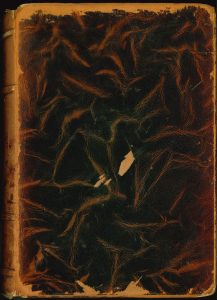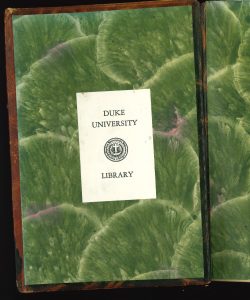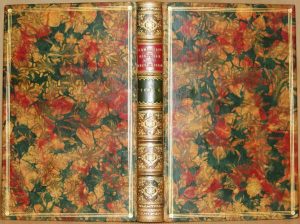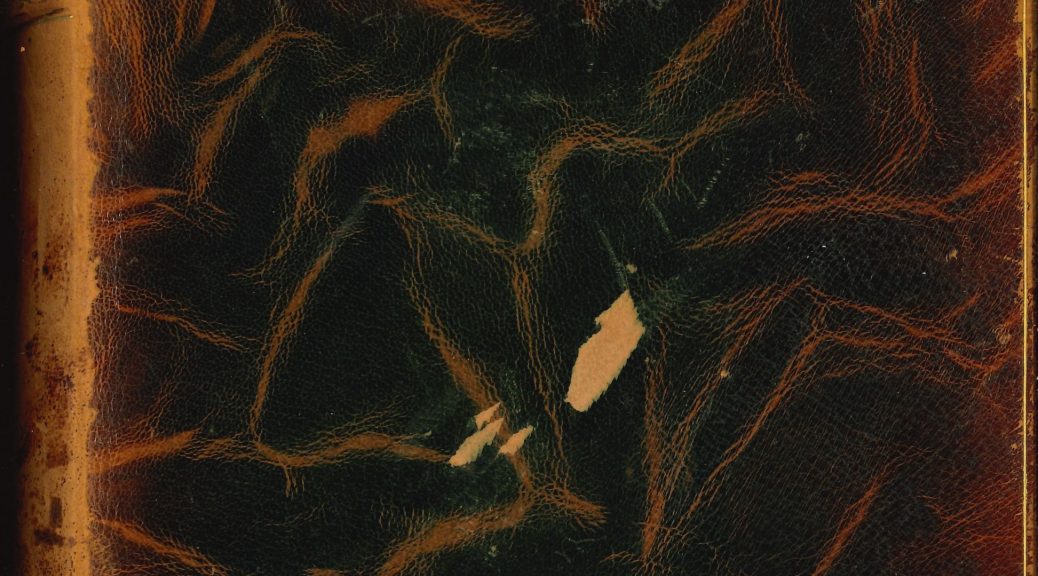By Mary Yordy, Senior Conservation Technician
The ghostly, rhythmic creased pattern in the leather covering this volume caught my eye when the set came through the lab for boxing. I wondered how it was done and if the technique had a name. I consulted with coworkers, but no one had seen anything quite like it. This first suggestion of the rarity of the technique was born out by additional efforts to share this image on social media and search down any leads in the literature on leather decoration. I was invited to compose a blog post about this unanswered question, which we present as an invitation to any of our followers who could shed light on the subject.

For lack of a known and accepted, term, I am calling the leather effect ‘crazed,’ indicating it’s similarity to finishes seen in ceramics and paint finishes. Inside the volume, the leather around the paste down and the leather hinge material are dark green, so this was presumably the original color of the leather, difficult to determine on the more degraded exterior. The leather must have been given this crazing prior to application to the structure.

The book is in Russian, v. 3 of an 8 volume set of Works of Pushkin published in St. Petersburg from 1903-1905. Oddly, only this one volume is full leather with ‘made’ end sheets using an inner hinge of the same leather and paste paper—the volumes before and after v. 3 are quarter bindings using the same leather on the spine and corners with book cloth sides and standard printed end sheets.
A member of a group to which I posted the image shared a photo revealing similar creasing in the leather covering a Spanish binding (Rosy Gray, on Bookbinding Art and Conservation on Facebook). The image she shared was of a much more colorful leather volume, and from an earlier historical period, but looking closely I could see that creasing was indeed part of the effect. She was experimenting to create the effect but had found little to guide her in the available literature.

Most embellishments of leather in binding (such as tree calf) occur after binding, but the crazing of this leather must have occurred prior to the application of the leather. If the methods used in Spanish Calf Marbling of the 17th-18th came more fully to light I suspect this would be true of it as well. Without knowing if I was getting warmer or colder I took the time to track down what information I could find about what is variously termed Pasta Espanola, Spanish Marbling, and Spanish Calf Marbling. English language materials on Spanish bookbinding history are scarce, with just a few examples of this style available for view online and no concrete descriptions of methods.
So the question remains. Has anyone seen this form of leather decoration before? Do you know of a term for it or how it was executed? An interesting question that might follow a definite identification of the technique as Spanish in origin would be how it happened to be used in Russia in the early 20th Century. Dissemination of a technique isn’t always how things come about—sometimes we are seeing completely separate iterations of an idea. It could be worth considering the fact that this volume was bound in a historical period that hosted the International Workingmen’s Association (Second) and various experiments in organizing industrial and trade work across borders, as well as significant industrial strikes.
Mary Yordy, Senior Conservation Technician, is retiring after over 30 years of service to the Libraries, almost 20 of those in Conservation. She leaves us with this unanswered question, and tens of thousands of items that have been repaired or boxed by her hands. You can see the impact of her work on every floor of the library. We will miss her presence in the lab. Thanks Mary! –Beth
Here’s a few of our favorite posts from and about Mary:
Sewing Models: Pandemic Edition
Look it up: The Encyclopedia Britannica 11th edition
Learning Together: Leather repair
10 Years, 10 People: Mary Yordy, Senior Conservation Technician
Preservation Week: Maintaining the circulating collections


